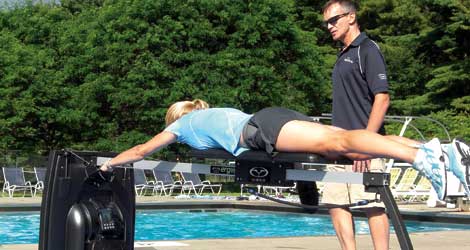Supplemental Swim Training: Shoemaker’s Secret Weapon
Olympian Jarrod Shoemaker's coach Tim Crowley uses the swim ergometer to build speed.

As American Olympian Jarrod Shoemaker’s coach, Tim Crowley has a daunting challenge ahead of him over the next two years: USA Triathlon predicts that times are going to get two per cent faster by the 2012 Olympic Games, which is why the organization is asking coaches like Crowley to come up with a three per cent improvement from his athletes in order to compete for a medal in London.
Crowley has worked as a strength and conditioning coach for over 20 years. He’s fully aware that in order to improve their swim times, athletes need to spend a lot of time in the pool. Crowley also knows that medals are won during the run. Which left him asking one simple question: “How do we make them really great in the swim without sacrificing their run?”
One of the answers Crowley has come up with over the last few years is more dedicated and precise work with the Vasa Ergometer. “A lot of people look at it as a swim replacement,” Crowley says, “But the way we use it, especially for our elite racers, is as a supplement to their other training. Often they’ll do a 15- or 20-minute ergometer workout in the morning and then swim in the afternoon.”
Initially Crowley used the ergometer as a “power meter for swimming,” providing an way to measure an athlete’s power output at various phases of the stroke. In the same way that cyclists have become more attuned to their power output, Crowley routinely uses the Vasa Ergometer to test whether his athletes are improving. He’ll have them do 100 m and 400 m time trials, analyzing their turnover rate and power output to see how they’re doing.
It didn’t take long, though, before he began to realize that the ergometer could be equally as good a tool for teaching technique to beginners.
“One of the biggest differences between good and bad swimmers is the way they accelerate their hands through the water,” he says. “Stronger swimmers will pull powerfully through the water, and their hands will move faster from the front of the stroke to the finish. It’s also a great way to work on body position. Unlike a lot of training tools, the ergometer really works from the time you enter the sport to whatever level you get to.”
Like many coaches, he uses other tools to help his athletes make improvements in the water. Crowley will often video athletes with an underwater camera, and then analyze their swim strokes with them, and like any self-respecting swim coach, stretch cords are a staple for rehabilitation work.
While Crowley likes the ability to measure power on the ergometer, you can get similar results from using a variety of other swim benches, too. Crowley points out that one of the major differences between good and weaker swimmers is the speed at which the hands move through the water. Faster swimmers will accelerate their hands through the water, while many weaker swimmers will maintain a constant speed from when their hands enter the water until they finish their stroke. Any tool you can find that will help demonstrate that – either an isokinetic swim bench or even surgical tubing attached to a set of hand paddles – will help you improve your stroke.
While Shoemaker will spend a lot of time in the pool over the next two years, he probably won’t spend quite as much time as some of his competitors. He’s trying to train smarter, not necessarily longer, than the rest of the men he’s hoping to face at the 2012 Olympic Games.
